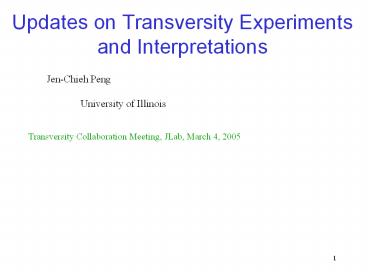Updates on Transversity Experiments and Interpretations - PowerPoint PPT Presentation
Title:
Updates on Transversity Experiments and Interpretations
Description:
Collins effect: Correlation between the quark's transverse spin with pion's pT ... Nachtmann and Mirkes proposed correlation between quark kT and its ... – PowerPoint PPT presentation
Number of Views:24
Avg rating:3.0/5.0
Title: Updates on Transversity Experiments and Interpretations
1
Updates on Transversity Experiments and
Interpretations
Jen-Chieh Peng
University of Illinois
Transversity Collaboration Meeting, JLab, March
4, 2005
2
Outline
- Recent results of SSA with transversely polarized
targets from HERMES and COMPASS - What are the implications on the transversity,
Collins fragmentation function, and Sivers quark
distributions? - Can existing models explain the SSA data from
HERMES for both the longitudinally polarized and
the transversely polarized targets? - What are the implications for the Hall-A
experiments? - What are the implications for polarized and
unpolarized Drell-Yan experiments.
3
Transversity distribution, Sivers distribution,
and Collins fragmentation function in
Semi-Inclusive DIS with transversely polarized
target
Unpolarized
Transversity
Polarized target
Sivers
Polarzied beam and target
SL and ST Target Polarizations ?e Beam
Polarization
4
Observation of Single-Spin Azimuthal Asymmetry
ep ? epx
HERMES
Longitudinally polarized target
ltSTgt 0.15
Origins of the azimuthal asymmetry (correlation
between the target nucleon transverse spin and
the pion transverse momentum)?
Collins effect Correlation between the quarks
transverse spin with pions pT in the
fragmentation process. Sivers effect Correlation
between the transverse spin of the proton with
the quarks transverse momentum. Other higher
twist effects could also contribute.
5
Model prediction of transversity
Chiral-quark soliton model
Similar to helicity distributions
Chiral-quark soliton model predicts Sivers
distribution is zero!
6
Comparison with HERMES longitudinal SSA data
Proton data
Deuteron data
Chiral-quark soliton model can describe the SSA
data very well (by including only the
transversity term)
7
p
Makins DNP04 talk
8
Comparison between the HERMES transversely
polarized target SSA data with Chiral-quark
soliton model
hep-ex/0412420
Disfavored Collins function 0
9
Comparison between the HERMES transversely
polarized target data with the Chiral-quark
soliton model
10
Comparison between the HERMES transversely
polarized data with the Chiral-quark soliton model
11
Implications of the HERMES SSA data
withtransversely polarized target
- Anselmino et al. showed that the Hermes SSA data
for longitudinally polarized data can be
explained by Sivers effect alone (without the
transversity/Collins effect). - However, the extracted Sivers function is much
larger (and of opposite sign) compare to the
HERMES SSA data with transversely polarized data.
hep-ph/0412316
12
First results from COMPASS transversely
polarized 6LiD
hep-ex/0503002
- Effects are expected to be small at small x
- Some cancellations between proton and neutron are
expected
13
Extraction of the Sivers distribution
Fits to the HERMES data on Sivers moments
(hep-ph/0412353)
14
SSA with Transversely Polarized Drell-Yan
Analysing power (AN) is sensitive to Sivers
function
Sivers function in Drell-Yan is expected to have
a sign opposite to that in DIS!
(Brodsky, Hwang, Schmidt, hep-ph/0206259
Collins, hep-ph/0204004)
- Prediction by Anselmino, DAlesio, Murgia
(hep-ph/0210371) for a negative AN. - AN increases with rapidity, y, and with
dilepton mass, M.
p? p ? l l- X
vs 200 GeV
AN
Is this measurement feasible at RHIC?
y
15
Expected statistical sensitivity for Drell-Yan AN
Assuming 400 pb-1 50 polarization
p? p ? l l- x
vs 200 GeV
6 lt M lt 10 GeV
- Might be feasible to determine the sign of the
Sivers function at RHIC - Should consider fixed-target polarized Drell-Yan
too
16
Sivers functions from SSA in polarized Drell-Yan
17
Cos2? Dependence in Unpolarized Drell-Yan
Large cos2? dependences have been observed in p
induced Drell-Yan
This azimuthal dependence could arise from a
product of KT-dependent distribution function h1-
( Boer, hep-ph/9902255 Boer, Brodsky, Hwang,
hep-ph/0211110)
In quark-diquark model, h1- is identical to
Sivers function
No Cos2? depenence for unpolarized p-p Drell-Yan
has been reported yet (The effect from h1- is
expected to be smaller)
- RHIC would provide unpolarized p-p Drell-Yan data
too - Fixed-target unpolarized p-p Drell-Yan data also
exist
18
Lam-Tung sum rule
(Conway et al.)
252 GeV p- W
Lam-Tung rule is violated and can not be
explained by pion bound state effect
19
Brandenburg, Nachtmann and Mirkes proposed
correlation between quark kT and its transverse
spin
D. Boer pointed out that h1- provides such
correlation
20
Unpolarized p-p and p-d dimuon production
Fermilab E866, vs 38.8 GeV
J/?
?
?
2.5 x 105 Drell-Yan events
21
? coverage of the E866 dimuon data
J/? events
Drell-Yan events
Not corrected for acceptance yet
22
Summary
- Transversity distribution remains an interesting
frontier in understanding spin structure in
nucleon. - Study of the T-odd Sivers structure function and
the Collins fragmentation function are important
for their own sake, and for extracting
information on transversity. - First results of SSA using transversely polarized
p and d targets are intriguing. The proposed
Hall-A measurement on 3He should provide very
useful new information. - New Semi-Inclusive DIS experiments at JLab will
continue to probe the flavor structure of
unpolarized and polarized parton distributions.































